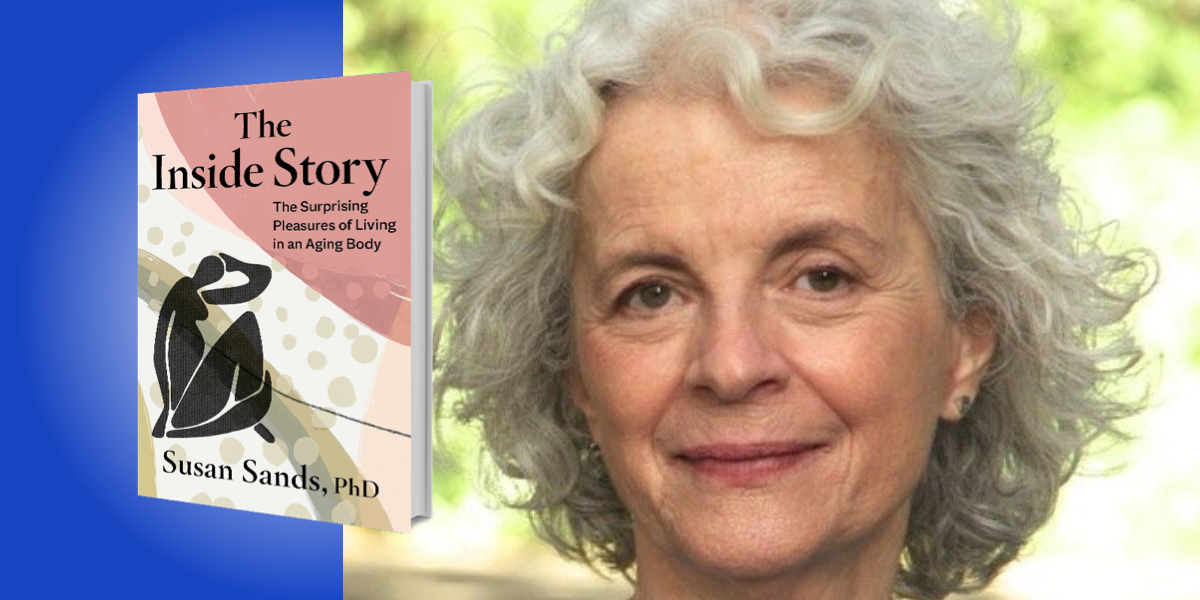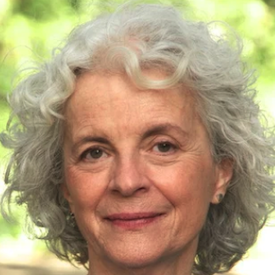Susan Sands is a clinical psychologist who specializes in female development and body-based disorders. In addition to private practice, she is a core faculty member at the Psychoanalytic Institute of Northern California and Assistant Clinical Professor of Psychology at UC Berkeley.
Below, Susan shares 5 key insights from her new book, The Inside Story: The Surprising Pleasures of Living in an Aging Body. Listen to the audio version—read by Susan herself—in the Next Big Idea App.

1. Our ageist culture is particularly hard on older women.
It’s not easy to get older in our youth-obsessed society. It’s hard to handle wrinkles, sags, aches, and losses. Sexism, as well as ageism, is rife in our culture so women get a double whammy. Thousands of media images of young, slim, sexy women bombard us daily, brainwashing us into believing that older people no longer “have it” and are no longer interesting or important. As a result, too many middle-aged or older women (I’m 75) anxiously fixate on how we look rather than how we feel. We think we look good only if we look young, which means we end up at war with our own bodies, trying to triumph over aging—a doomed enterprise.
Society’s picture of an ideal body weight began dropping precipitously in the 1970’s and 80’s until the thin ideal became entrenched in the 90’s and has persisted ever since. The thin ideal is not achievable for most women beyond adolescence, and it gets even harder in middle age. A large majority of western women are dissatisfied with their bodies and cosmetic procedures have increased by a third over the last decade.
It’s all so sad. Trying to defeat aging is a way of rejecting ourselves. Not letting ourselves age is a way of not letting ourselves live. We need to forge a healthier relationship with our actual maturing bodies—a relationship of respect, appreciation, tenderness, and love.
2. Body awareness is key for aging comfortably.
Many of us feel alienated from our bodies because we’ve never been encouraged to get to know, sense, and feel our bodies. When we were growing up, hardly anyone went to the gym and if we did yoga it was just some new thing to check out. We didn’t learn to pay attention to our bodies in an ongoing way. Our society privileges thinking over feeling, conceptual self-awareness over embodied self-awareness. As a result, we’re disconnected from our somatic selves.
But’s it’s never too late to tune inwards and become deeply aware of your inner body sensations. This way we can figure out what we need to live well and how to get it. When you feel better in your body, you feel better about your body.
“When you feel better in your body, you feel better about your body.”
The exciting new science of interoception is confirming all of this. Hundreds of brain scan studies have established that our emotions, our mind, are created from body sensations. The interoceptive process gives an ongoing readout on how we’re doing physiologically, which helps ensure survival and creates emotional awareness. Interoceptive awareness is like a sixth sense: your sense of being you. Feeling rooted in your body is crucial for well-being.
Scientific studies of interoceptive awareness (IA) confirm that it leads to better emotion regulation, sharper attention, increased happiness, presence, agency, empathy, compassion, firmer self-other boundaries, and a more stable and accurate body image. People with high IA are less influenced by external stimuli which protects from insidious cultural values.
I call interoceptive awareness body sense to be distinguished from body image, which is how we imagine ourselves or how others see us. We have a strong and positive body sense if we are able to pay attention to our sensations, emotions, and movements in the present moment. Without a well-developed body sense, our body image will feel like an abstract, often inaccurate, idea of who we are. A stable and positive body image fits like a comfortable suit.
The importance of building body awareness for aging has not received its due by aging experts, despite being precisely what aging bodies need. As our bodies become less robust and reliable, we need to feel firmly rooted in and aware of our bodies so that we know how to take excellent care of ourselves. We must feel grounded internally as we become less adept externally.
3. You can learn to develop your body awareness.
A strong body sense doesn’t just happen—it must be actively cultivated and renewed. We can build interoceptive awareness right here and now by moving our attention into our bodies and dwelling there, sensing ourselves from within. We may notice immediately how relieving it is to feel grounded in our body, away from our thinking mind. We can then check in with our bodies, to see what’s going on and what we need. When we focus in on a part of our body—for example, our sore back—then we build up the part of our brain that interoceptively monitors our back and we can more easily adjust our back from then on. If we develop IA, we’re less likely to suffer debilitating physical and mental health conditions because we can treat minor problems before they progress to serious conditions. For example, managing high blood sugar before it progresses to diabetes.
“Long-term meditators have less gray-matter atrophy than non-meditators of the same age; their brains looked more like those of people 7-8 years younger.”
There are also wonderful contemplative practices that develop body awareness. Mindfulness meditation and other body-based meditative practices like sustained breathing, yoga, tai chi, and chanting are tried and true. Mindfulness is as effective as medication in treating anxiety and depression, without side effects. And don’t forget exercise, diet, and sleep. Studies show that long-term meditators have less gray-matter atrophy than non-meditators of the same age; their brains looked more like those of people 7-8 years younger. Tibetan lamas who meditate full-time have astonishingly youthful brains.
Meditation has also been shown to increase the length of our telomeres (the little caps on the end of DNA strands that shorten every time a cell divides), thereby increasing our life span.
Neuroplasticity, the capacity of the brain to change in response to experience and practice, continues into older age. We can keep sprouting connections and even growing new neurons. If we stay grounded in our bodies, we can keep revising our bodies until the very end.
4. Challenge ageist beliefs.
To age well, we must challenge ageism—particularly our own. Ageism directed against ourselves lives in our bodies as well as in our minds, stooping our shoulders, wobbling our balance, and scrambling our brains. The internalization of negative aging stereotypes begins in childhood, when we adopt the attitudes of our family and cultural environment. It’s the only remaining prejudice which is still generally accepted, or unnoticed. Ironically, it is also the only “ism” directed toward our future selves.
We need to observe our minds closely in order to ferret out and uproot ageist beliefs. What ageist messages do you send? Do you lie about your age? Do you assume that younger people don’t want to talk with you because you’re boring? These notions make older age a time of struggle and disappointment when it can be a time of unprecedented freedom, joy, and awakening.
A series of eye-popping epidemiological studies show that people with more positive views of aging (measured years earlier) live seven-and-a-half years longer. They are also less likely to develop Alzheimer’s, have a heart attack, or develop serious disability.
“Ageism directed against ourselves lives in our bodies as well as in our minds, stooping our shoulders, wobbling our balance, and scrambling our brains.”
What if we became part of a movement to usher in a different vision of aging? Older generations fought for rights of women, people of color, different sexual/gender identities, but we haven’t adequately addressed age inequality. What if we dump our iconic image of aging as an arc, where middle age is at the peak of the curve, before we slide down to bleak older years? What if we substitute an upward spiral with multiple possible trajectories? What if we saw older age as fulfillment, not decline; culmination rather than epilogue?
5. Enjoy living in your older body!
We can feel better as we age if we keep building body awareness and filtering ageist beliefs. All of the almost 30 women I interviewed said that their lives have improved with age. Most said they feel less anxious, more sense of self, and an it-is-what-it-is mentality.
A wealth of research confirms that we get mentally healthier as we age. Studies reveal a U-shaped happiness curve over the lifespan, with people happiest in their younger and older years and least happy in midlife. The year of greatest happiness appears to be around age 82. There’s also a positivity bias. The older you are, the more likely that you put a positive slant on the relationships and events of your life.
Why are we happier when we’re dealing with the manifold losses and difficulties of aging? One explanation is a different sense of time: we recognize that time is limited and want to savor what is left. There’s a new sense of present time, being in the moment. There is greater integrity—a radical acceptance of who you’ve become. Our greater ability to empathize makes interpersonal relationships easier. Facing mortality makes us accept the realities of our lives.
Body dissatisfaction does not increase with age, but tends to stay the same or decline. Older women have higher levels of body appreciation, meaning accepting and respecting our bodies. We also gain more appreciation of bodily ability—for example, staying strong and healthy.
Certain normal age-related brain changes make our bodies less reactive and more mellow. There is a waning of the amygdala (the part of the brain that generates emotional reactions) and our interoceptive sensations become less intense, so we are more able to take higher-brain control of potentially upsetting situations. There is less dramatic action in our inner theater without the hormonal tumult of youth. We can sense our bodies more deeply and pleasurably as we get older. We can become more embodied. It is my belief that some people can only become truly embodied in older age.
To listen to the audio version read by author Susan Sands, download the Next Big Idea App today:































